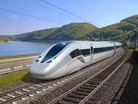Siemens leads e-mobility innovation for commute services

Electric mobility (e-mobility) is the unachievable vision made possible. Not only will it meet the needs of the climate, but it holds the potential for high speed transport capabilities, making it beneficial for commuters.
Following the Siemens Transform 2022 conference we’ve become more aware of the applications the company has developed to facilitate the shift to e-mobility.
The company is developing next generation smart solutions for EV charging and electrification infrastructure, but intercity transportation could be made a lot simpler, and faster, with the Velaro Novo—a high-speed train like no other.
A commute service enabled by technology
The mechanical aspect of transportation is no longer the differentiating factor. Many solutions are now using the same hardware, therefore paving the way for software to take precedence. This is where Siemens is strategically positioned in the industry and some of the features of the Velaro Novo will showcase the future capabilities of technology.
The demand for flexibility is one of the key focal points of the Velaro Novo design as it increases its potential capacity by 10% and the ‘empty tube’ concept of the vehicle creates a sleek and more functional internal space while technical components are kept away from the interior. The design of the train is also adaptable depending on the route that it takes and can be fitted with different interior design elements and further traction points.
As the train is developed to meet future mobility requirements, smart drive functions are in development to enhance the train’s efficiency, which, for commuters, would make it a lot more reliable than conventional trains. The way that Siemens describes this is ‘intelligent motion’, providing great benefits to the new train model.
The train runs on units called ‘inbound bogies’, which contain the bearings for the vehicle to make it run much smoother, limiting wear and tear from transit as well as protecting the train from snow, ice and gravel. Siemens has tried and tested this technology and coupled it with years of experience in the engineering space. Currently the firm has supplied technology to more than 1,000 Velaro model trains in operation with the more than three billion kilometres covered at rates of up to 380 kilometres per hour.
EV provides holistic cost efficiency
The latest Velaro model excels in velocity, due to its 15% weight reduction—making it 70 tonnes lighter. It also comes at a more appealing cost. Operators of the Velaro Novo are expected to see a reduced total cost, consisting of a 20% lower investment in the train. They will also see a 30% lower figure spent on maintenance and servicing.
The design of the train is also devised for aerodynamics, which will save both the train operators and their passengers on a further cost, time. The use of intelligent design principles allows the lightweight train to reach its destinations much faster and make commuting to work a much better experience.


